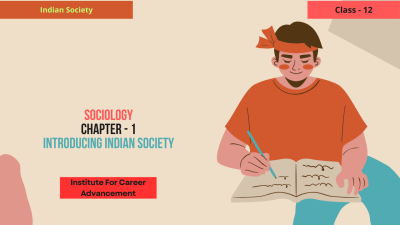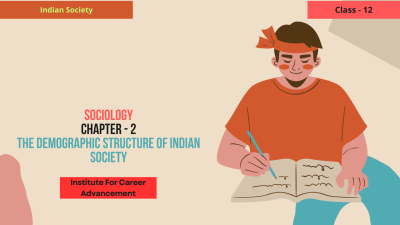Course description
The Class 11 Sociology chapter on "Indian Sociologists" introduces students to the major Indian thinkers who have contributed significantly to the development of sociology in India. This chapter explores the key ideas, theories, and contributions of Indian sociologists in understanding Indian society, culture, and social structures. It also emphasizes how Indian sociologists have adapted, critiqued, and expanded upon Western sociological theories to reflect the unique social realities of India.
Course Overview:
1. Introduction to Indian Sociology
Understanding the emergence of sociology as a discipline in India.
Exploration of the socio-political context in which Indian sociology developed.
Comparison of Indian sociology with Western sociology and the need for a distinctive Indian perspective.
2. Pioneers of Indian Sociology
G.S. Ghurye (1893-1983): His work on caste, race, and Indian society.
M.N. Srinivas (1916-1999): Known for the concepts of "Sanskritization," "Dominant Caste," and his study of social mobility in Indian society.
A.R. Desai (1915-1994): His Marxist approach to studying Indian society, especially the role of the state and class.
D.P. Mukerji (1894-1961): His focus on the cultural and historical aspects of Indian society and the idea of modernity.
Irawati Karve (1905-1970): Contributions to the study of kinship, family structure, and the role of women in Indian society.
3. Key Themes in Indian Sociology
Caste and Social Stratification: Examination of caste as a central theme in Indian sociological studies. The role of caste in social mobility, hierarchy, and power structures.
Village Studies: Focus on rural sociology and the analysis of Indian villages as microcosms of Indian society. Understanding rural life, land relations, and social change.
Religion and Society: The role of religion in shaping Indian social practices, beliefs, and institutions. The intersection of religion and politics.
Urbanization and Modernity: Impact of modernization and urbanization on Indian social structures. How Indian sociologists analyzed the transformation of cities and migration patterns.
Family and Kinship: Study of traditional family structures, changing family patterns, and the role of kinship in Indian society.
Tribal Societies: Exploration of India’s tribal communities, their unique social structures, and the challenges they face.
4. Key Concepts Developed by Indian Sociologists
Sanskritization: M.N. Srinivas’s concept that explains how lower castes attempt to improve their social status by adopting practices of higher castes.
Dominant Caste: Another key concept from Srinivas that examines the role of powerful castes in local hierarchies.
Westernization: Srinivas's analysis of the influence of Western ideas and institutions on Indian society.
Modernity in India: D.P. Mukerji’s exploration of the conflict between tradition and modernity in Indian society.
Rural-Urban Continuum: The interconnectedness of rural and urban areas in terms of economy, culture, and social structures.
5. Sociological Methods in India
Examination of the methods used by Indian sociologists to study society, including fieldwork, ethnography, and historical analysis.
The use of case studies, especially in village studies and caste analysis.
Challenges faced by Indian sociologists in adapting Western methodologies to study Indian social contexts.
6. Application of Indian Sociological Thought
Understanding contemporary Indian society through the lens of Indian sociologists’ contributions.
Examining social issues like poverty, inequality, caste-based discrimination, communalism, and the role of the state in addressing these issues.
7. Critique and Relevance of Indian Sociologists
Critical evaluation of the contributions of Indian sociologists and their relevance in today’s context.
The limitations and critiques of their approaches, particularly in terms of addressing gender, regional diversity, and economic inequality.
Objectives of the Chapter:
To introduce students to the major Indian sociologists and their contributions to understanding Indian society.
To provide an overview of key themes in Indian sociology, including caste, village studies, family, religion, and social change.
To encourage students to critically analyze Indian social structures using the theoretical tools developed by Indian sociologists.
To demonstrate the importance of a uniquely Indian sociological perspective in studying the complexities of Indian society.
This chapter offers students a comprehensive view of Indian sociological thought, highlighting the significance of understanding social issues in the Indian context, and the unique contributions Indian sociologists have made to global sociological discourse.
"ভারতীয় সমাজবিজ্ঞানীদের" উপর 11 তম শ্রেণীর সমাজবিজ্ঞান অধ্যায়টি শিক্ষার্থীদের প্রধান ভারতীয় চিন্তাবিদদের সাথে পরিচয় করিয়ে দেয় যারা ভারতে সমাজবিজ্ঞানের বিকাশে উল্লেখযোগ্য অবদান রেখেছেন। এই অধ্যায়টি ভারতীয় সমাজ, সংস্কৃতি এবং সামাজিক কাঠামো বোঝার ক্ষেত্রে ভারতীয় সমাজবিজ্ঞানীদের মূল ধারণা, তত্ত্ব এবং অবদানের অন্বেষণ করে। এটি আরও জোর দেয় যে কীভাবে ভারতীয় সমাজবিজ্ঞানীরা ভারতের অনন্য সামাজিক বাস্তবতা প্রতিফলিত করার জন্য পশ্চিমা সমাজতাত্ত্বিক তত্ত্বগুলিকে মানিয়ে নিয়েছেন, সমালোচনা করেছেন এবং প্রসারিত করেছেন।
কোর্স ওভারভিউঃ
1টি। ভারতীয় সমাজবিজ্ঞানের পরিচিতি
ভারতে একটি শাখা হিসাবে সমাজবিজ্ঞানের উত্থানকে বোঝা।
ভারতীয় সমাজবিজ্ঞান যে সামাজিক-রাজনৈতিক প্রেক্ষাপটে বিকশিত হয়েছিল তার অন্বেষণ।
পাশ্চাত্য সমাজবিজ্ঞানের সঙ্গে ভারতীয় সমাজবিজ্ঞানের তুলনা এবং একটি স্বতন্ত্র ভারতীয় দৃষ্টিভঙ্গির প্রয়োজনীয়তা।
2. ভারতীয় সমাজবিজ্ঞানের অগ্রগামীরা
G.S. ঘুর্যে (1893-1983) জাতপাত, বর্ণ ও ভারতীয় সমাজ নিয়ে তাঁর কাজ।
M.N. শ্রীনিবাস (1916-1999) তিনি "সংস্কৃতকরণ", "প্রভাবশালী বর্ণ" এবং ভারতীয় সমাজে সামাজিক গতিশীলতা অধ্যয়নের জন্য পরিচিত।
A.R. দেশাই (1915-1994) ভারতীয় সমাজ, বিশেষত রাষ্ট্র ও শ্রেণীর ভূমিকা অধ্যয়নের জন্য তাঁর মার্কসবাদী দৃষ্টিভঙ্গি।
D.P. মুখার্জি (1894-1961) ভারতীয় সমাজের সাংস্কৃতিক ও ঐতিহাসিক দিক এবং আধুনিকতার ধারণার উপর তাঁর দৃষ্টি।
ইরাবতী কারভে (1905-1970) আত্মীয়তা, পারিবারিক কাঠামো এবং ভারতীয় সমাজে মহিলাদের ভূমিকা অধ্যয়নে অবদান।
3. ভারতীয় সমাজবিজ্ঞানের মূল বিষয়গুলি
বর্ণ ও সামাজিক স্তরবিন্যাসঃ ভারতীয় সমাজতাত্ত্বিক অধ্যয়নের কেন্দ্রীয় বিষয় হিসাবে বর্ণের পরীক্ষা। সামাজিক গতিশীলতা, শ্রেণিবিন্যাস এবং ক্ষমতার কাঠামোতে বর্ণের ভূমিকা।
গ্রাম অধ্যয়নঃ গ্রামীণ সমাজবিজ্ঞান এবং ভারতীয় সমাজের ক্ষুদ্র অংশ হিসাবে ভারতীয় গ্রামগুলির বিশ্লেষণের উপর ফোকাস করুন। গ্রামীণ জীবন, ভূমি সম্পর্ক এবং সামাজিক পরিবর্তনকে বোঝা।
ধর্ম ও সমাজঃ ভারতীয় সামাজিক চর্চা, বিশ্বাস ও প্রতিষ্ঠান গঠনে ধর্মের ভূমিকা। ধর্ম ও রাজনীতির মিলন।
নগরায়ন ও আধুনিকতাঃ ভারতীয় সামাজিক কাঠামোর উপর আধুনিকীকরণ ও নগরায়নের প্রভাব। ভারতীয় সমাজবিজ্ঞানীরা কীভাবে শহরগুলির রূপান্তর এবং অভিবাসনের ধরণ বিশ্লেষণ করেছেন।
পরিবার ও আত্মীয়তাঃ ঐতিহ্যবাহী পারিবারিক কাঠামো, পরিবর্তিত পারিবারিক নিদর্শন এবং ভারতীয় সমাজে আত্মীয়তার ভূমিকা নিয়ে অধ্যয়ন।
উপজাতি সমাজঃ ভারতের উপজাতি সম্প্রদায়ের অন্বেষণ, তাদের অনন্য সামাজিক কাঠামো এবং তারা যে চ্যালেঞ্জগুলির মুখোমুখি হয়।
4. ভারতীয় সমাজবিজ্ঞানীদের উদ্ভাবিত মূল ধারণাগুলি
সংস্কৃতকরণঃ M.N. শ্রীনিবাসের ধারণাটি ব্যাখ্যা করে যে কীভাবে নিম্ন বর্ণগুলি উচ্চ বর্ণের অনুশীলনগুলি গ্রহণ করে তাদের সামাজিক অবস্থানের উন্নতির চেষ্টা করে।
প্রভাবশালী বর্ণঃ শ্রীনিবাসের আরেকটি মূল ধারণা যা স্থানীয় শ্রেণিবিন্যাসে শক্তিশালী বর্ণের ভূমিকা পরীক্ষা করে।
পাশ্চাত্যকরণঃ ভারতীয় সমাজে পাশ্চাত্যের ধারণা ও প্রতিষ্ঠানের প্রভাব সম্পর্কে শ্রীনিবাসের বিশ্লেষণ।
ভারতে আধুনিকতাঃ D.P. ভারতীয় সমাজে ঐতিহ্য এবং আধুনিকতার মধ্যে দ্বন্দ্ব নিয়ে মুখার্জির অনুসন্ধান।
গ্রামীণ-নগর ধারাবাহিকতাঃ অর্থনীতি, সংস্কৃতি এবং সামাজিক কাঠামোর পরিপ্রেক্ষিতে গ্রামীণ ও শহুরে অঞ্চলের আন্তঃসংযোগ।
5. ভারতে সামাজিক পদ্ধতি
সমাজ অধ্যয়নের জন্য ভারতীয় সমাজবিজ্ঞানীদের দ্বারা ব্যবহৃত পদ্ধতিগুলির পরীক্ষা, যার মধ্যে রয়েছে ক্ষেত্রের কাজ, নৃতাত্ত্বিক এবং ঐতিহাসিক বিশ্লেষণ।
বিশেষ করে গ্রাম অধ্যয়ন এবং বর্ণ বিশ্লেষণে কেস স্টাডির ব্যবহার।
ভারতীয় সামাজিক প্রেক্ষাপট অধ্যয়নের জন্য পশ্চিমা পদ্ধতিগুলি গ্রহণ করার ক্ষেত্রে ভারতীয় সমাজবিজ্ঞানীদের সম্মুখীন হওয়া চ্যালেঞ্জ।
6টি। ভারতীয় সমাজতাত্ত্বিক চিন্তার প্রয়োগ
ভারতীয় সমাজবিজ্ঞানীদের অবদানের লেন্সের মাধ্যমে সমসাময়িক ভারতীয় সমাজকে বোঝা।
দারিদ্র্য, অসমতা, বর্ণভিত্তিক বৈষম্য, সাম্প্রদায়িকতা এবং এই সমস্যাগুলির সমাধানে রাষ্ট্রের ভূমিকার মতো সামাজিক বিষয়গুলি পরীক্ষা করা।
7. ভারতীয় সমাজবিজ্ঞানীদের সমালোচনা ও প্রাসঙ্গিকতা
ভারতীয় সমাজবিজ্ঞানীদের অবদান এবং আজকের প্রেক্ষাপটে তাদের প্রাসঙ্গিকতার সমালোচনামূলক মূল্যায়ন।
তাদের পদ্ধতির সীমাবদ্ধতা এবং সমালোচনা, বিশেষ করে লিঙ্গ, আঞ্চলিক বৈচিত্র্য এবং অর্থনৈতিক বৈষম্য মোকাবেলার ক্ষেত্রে।
অধ্যায়ের উদ্দেশ্যঃ প্রধান ভারতীয় সমাজবিজ্ঞানী এবং ভারতীয় সমাজকে বোঝার ক্ষেত্রে তাদের অবদানের সাথে শিক্ষার্থীদের পরিচয় করিয়ে দেওয়া।
বর্ণ, গ্রাম অধ্যয়ন, পরিবার, ধর্ম এবং সামাজিক পরিবর্তন সহ ভারতীয় সমাজবিজ্ঞানের মূল বিষয়গুলির একটি সংক্ষিপ্ত বিবরণ প্রদান করা।
ভারতীয় সমাজবিজ্ঞানীদের দ্বারা বিকশিত তাত্ত্বিক সরঞ্জামগুলি ব্যবহার করে ভারতীয় সামাজিক কাঠামো সমালোচনামূলকভাবে বিশ্লেষণ করতে শিক্ষার্থীদের উৎসাহিত করা।
ভারতীয় সমাজের জটিলতা অধ্যয়নে একটি অনন্য ভারতীয় সমাজতাত্ত্বিক দৃষ্টিভঙ্গির গুরুত্ব প্রদর্শন করা।
এই অধ্যায়টি শিক্ষার্থীদের ভারতীয় প্রেক্ষাপটে সামাজিক বিষয়গুলি বোঝার গুরুত্ব এবং বৈশ্বিক সমাজতাত্ত্বিক আলোচনায় ভারতীয় সমাজবিজ্ঞানীদের অনন্য অবদান তুলে ধরে ভারতীয় সমাজতাত্ত্বিক চিন্তাভাবনার একটি বিস্তৃত দৃষ্টিভঙ্গি প্রদান করে।



















